warning light KIA Magnetis 2006 2.G Owner's Manual
[x] Cancel search | Manufacturer: KIA, Model Year: 2006, Model line: Magnetis, Model: KIA Magnetis 2006 2.GPages: 225, PDF Size: 3.77 MB
Page 13 of 225
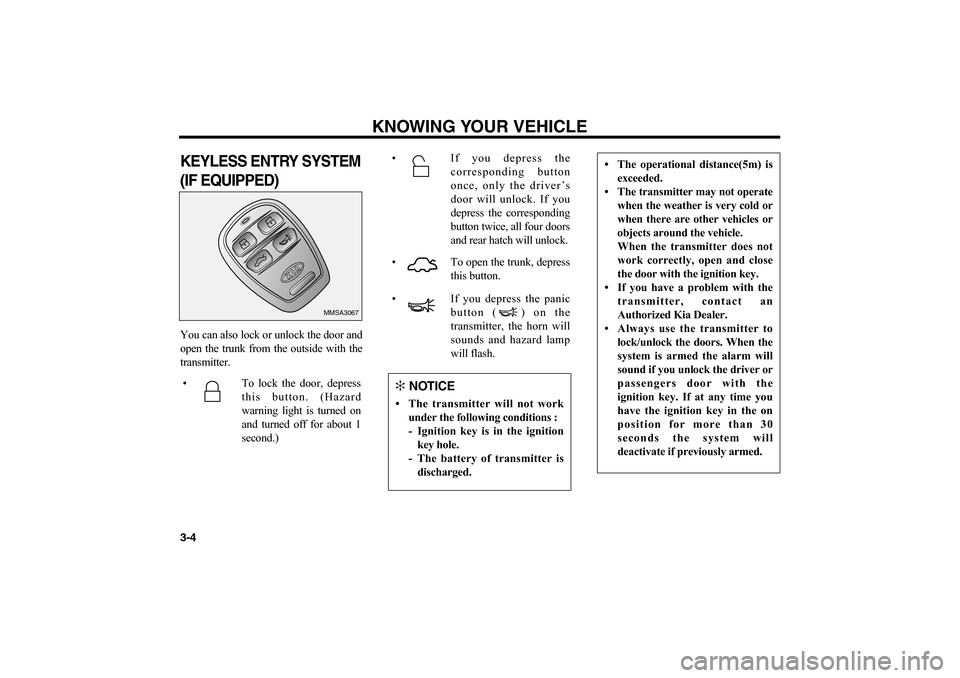
KEYLESS ENTRY SYSTEM
(IF EQUIPPED)You can also lock or unlock the door and
open the trunk from the outside with the
transmitter.
KNOWING YOUR VEHICLE
3-4
MMSA3067
• To lock the door, depress
this button. (Hazard
warning light is turned on
and turned off for about 1
second.)• If you depress the
corresponding button
once, only the driver’s
door will unlock. If you
depress the corresponding
button twice, all four doors
and rear hatch will unlock.
• To open the trunk, depress
this button.• If you depress the panic
button ( ) on the
transmitter, the horn will
sounds and hazard lamp
will flash.✻
NOTICE
• The transmitter will not work
under the following conditions :
- Ignition key is in the ignition
key hole.
- The battery of transmitter is
discharged.
• The operational distance(5m) is
exceeded.
• The transmitter may not operate
when the weather is very cold or
when there are other vehicles or
objects around the vehicle.
When the transmitter does not
work correctly, open and close
the door with the ignition key.
• If you have a problem with the
transmitter, contact an
Authorized Kia Dealer.
• Always use the transmitter to
lock/unlock the doors. When the
system is armed the alarm will
sound if you unlock the driver or
passengers door with the
ignition key. If at any time you
have the ignition key in the on
position for more than 30
seconds the system will
deactivate if previously armed.
MS-CNA-Eng 3.QXD 7/25/2005 5:17 PM Page 4
Page 14 of 225

BATTERY REPLACEMENTThe transmitter uses a 3-Volt, lithium-
type battery. The battery will normally
last for several years. If it ever needs
replacement, use the following
procedure:
1. Using a screwdriver, loosen the
screw on the back of the transmitter
and pry the back off with a thin tool.
2. Remove the battery from the back.
3. Insert a new battery, making sure the
“Plus(+)” side faces up, and
reassemble the transmitter.
THEFT - ALARM SYSTEM
(IF EQUIPPED)ARMED STAGEThe system is armed as described
below.• After all vehicle doors such as the
engine hood, trunk and passenger
doors are closed, when the
transmitter “Lock” button is pressed,
the doors are locked and the vehicle’s
hazard warning light blinks once. (At
this time, the alarm does not sound.)
3-5
MMSA3068
HMR.082
CAUTION
Using an incorrect battery can
cause the transmitter to
malfunction. Make sure the
replacement battery has the same
specification as the battery it
replaces.
MS-CNA-Eng 3.QXD 7/25/2005 5:17 PM Page 5
Page 19 of 225

OPERATING DOOR LOCKS
FROM INSIDE THE VEHICLE• To lock a door, push the door lock
button to the “LOCK” position.
• To unlock a door, push the door lock
button to the “UNLOCK” position.
• To open a door, pull the door handle
towards the middle of your vehicle.
The door ajar warning light will
illuminate if a door is not fully closed.
Close the door completely and the light
will go out.
POWER DOOR LOCKS
(IF EQUIPPED)The power door lock switch is located on
the driver’s armrest. If any door is open
when the switch is depressed, the door
will remain locked when closed.
KNOWING YOUR VEHICLE
3-10
MMSA3004
UNLOCKLOCK
MMSA3003
UNLOCK
RED MARK
LOCK
WARNING
Never leave children or animals
unattended in the vehicle. An
enclosed vehicle can become
extremely hot and depleted of
oxygen, causing death or
severe injury to children or to
animals who cannot escape the
vehicle.
CAUTION
The doors should always be fully
closed and locked while the vehicle
is in motion to prevent accidental
opening of the doors. Locked doors
will also discourage potential
intruders when the vehicle stops or
slows.✻
NOTICE
When the door is locked, the red
mark on the switch is not visible.
✻
NOTICE• Pushing the front portion of the
driver’s door lock switch will
cause all vehicle doors to lock.
• Pushing the rear portion of the
switch will cause all vehicle
doors to unlock.
MS-CNA-Eng 3.QXD 7/25/2005 5:17 PM Page 10
Page 22 of 225

POWER WINDOW LOCK
SWITCH FEATUREThe driver can disable the power window
switches on all passenger doors by
depressing the power window lock switch
located on the driver’s door to ON. When
the power window lock switch is ON, the
driver’s master control can not operate the
passenger door power windows either.
PASSENGER DOOR POWER
WINDOW CONTROLSTo open a window, press the front portion
of the switch down. To close a window,
pull the front portion of the switch up.
3-13
MMSA3006
WARNING - Power
Windows
Keep the power window lock
switch on the driver’s door in
the ON (depressed) position
except when someone is
operating a passenger door
window. Serious injury can
result from unintentional
window opera-tion, especially
to children.
Always double check to make
sure all arms, hands, and other
obstructions are safely out of
the way before closing a
window.✻
NOTICE
If you experience buffeting and
pulsation (wind shock) with either
side window open, you should open
the opposite window slightly to
reduce the condition.
WARNING - Passengers
Do not allow children to play
with the power windows. They
may seriously injure
themselves or others.
MMSA3004
Power window lock switch
MS-CNA-Eng 3.QXD 7/25/2005 5:17 PM Page 13
Page 24 of 225
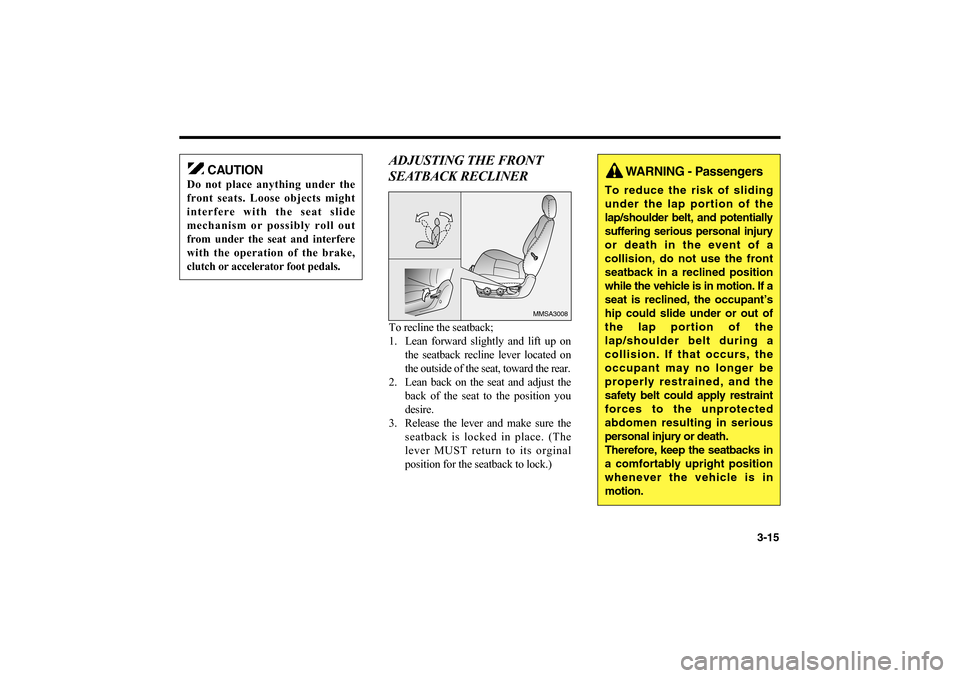
ADJUSTING THE FRONT
SEATBACK RECLINERTo recline the seatback;
1. Lean forward slightly and lift up on
the seatback recline lever located on
the outside of the seat, toward the rear.
2. Lean back on the seat and adjust the
back of the seat to the position you
desire.
3. Release the lever and make sure the
seatback is locked in place. (The
lever MUST return to its orginal
position for the seatback to lock.)
3-15
MMSA3008
CAUTION
Do not place anything under the
front seats. Loose objects might
interfere with the seat slide
mechanism or possibly roll out
from under the seat and interfere
with the operation of the brake,
clutch or accelerator foot pedals.
WARNING - Passengers
To reduce the risk of sliding
under the lap portion of the
lap/shoulder belt, and potentially
suffering serious personal injury
or death in the event of a
collision, do not use the front
seatback in a reclined position
while the vehicle is in motion. If a
seat is reclined, the occupant’s
hip could slide under or out of
the lap portion of the
lap/shoulder belt during a
collision. If that occurs, the
occupant may no longer be
properly restrained, and the
safety belt could apply restraint
forces to the unprotected
abdomen resulting in serious
personal injury or death.
Therefore, keep the seatbacks in
a comfortably upright position
whenever the vehicle is in
motion.
MS-CNA-Eng 3.QXD 7/25/2005 5:17 PM Page 15
Page 31 of 225
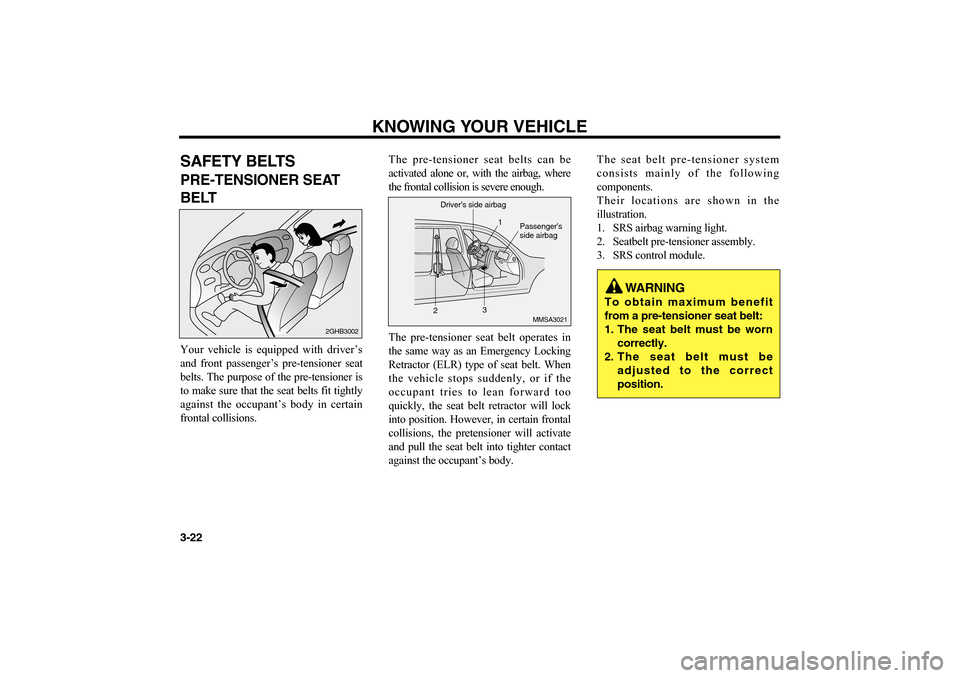
KNOWING YOUR VEHICLE
3-22SAFETY BELTSPRE-TENSIONER SEAT
BELTYour vehicle is equipped with driver’s
and front passenger’s pre-tensioner seat
belts. The purpose of the pre-tensioner is
to make sure that the seat belts fit tightly
against the occupant’s body in certain
frontal collisions.The pre-tensioner seat belts can be
activated alone or, with the airbag, where
the frontal collision is severe enough.
The pre-tensioner seat belt operates in
the same way as an Emergency Locking
Retractor (ELR) type of seat belt. When
the vehicle stops suddenly, or if the
occupant tries to lean forward too
quickly, the seat belt retractor will lock
into position. However, in certain frontal
collisions, the pretensioner will activate
and pull the seat belt into tighter contact
against the occupant’s body.The seat belt pre-tensioner system
consists mainly of the following
components.
Their locations are shown in the
illustration.
1. SRS airbag warning light.
2. Seatbelt pre-tensioner assembly.
3. SRS control module.
2GHB3002
MMSA3021
Driver’s side airbag
21
3Passenger’s
side airbag
WARNING
To obtain maximum benefit
from a pre-tensioner seat belt:
1. The seat belt must be worn
correctly.
2. The seat belt must be
adjusted to the correct
position.
MS-CNA-Eng 3.QXD 7/25/2005 5:17 PM Page 22
Page 32 of 225

3-23
✻
NOTICE
• Both the driver’s and front
passenger’s pre-tensioner seat
belts will be activated in certain
frontal collisions. The pre-
tensioner seat belts can be
activated alone or, where the
frontal collision is severe enough,
with the airbags. The pre-
tensioners will be activated
under these conditions even if
the seat belts are not being worn
at the time of the collision.
• When the pre-tensioner seat
belts are activated, a loud noise
may be heard and fine dust,
which may appear to be smoke,
may be visible in the passenger
compartment. This dust is not
hazardous.
• Although it is harmless, the fine
dust may cause skin irritation
and should not be breathed for
prolonged periods. Wash your
hands and face thoroughly after
an accident in which the
pretensioner seat belts were
activated.
CAUTION
• Because the sensor that activates
the SRS airbag is connected with
pre-tensioner seat belt, the SRS
airbag warning light on the
instrument panel will blink for
approximately 6 seconds after
the ignition key has turned to the
“ON” or “ACC” positions. After
the six second period, the air bag
warning light will turn off.
• Please have the SRS airbag
system and the pre-tensioner
system inspected by an
Authorized Kia Dealer if the
following conditions occur:
1. The SRS warning light does
not illuminate when the
ignition switch is turned to
“ON” or “ACC”.
2. When the ignition switch is
turned to “ON” or “ACC” the
SRS warning light stays lit
after blinking for
approximately 6 second.
3. The SRS warning light illum-
inates while the vehicle is being
driven.
AIR
BAG
WARNING
Pre-tensioners are designed
to operate only one time.
After activation, pretensioner
seat belts must be replaced.
All seat belts, of any type,
should always be replaced
after they have been worn
during a collision.
The Pre-tensioner seat belt
assembly mechanisms
become hot during
activation. Do not touch the
pre-tensioner seat belt
assemblies for several
minutes after they have been
activated.
Do not attempt to inspect or
replace the pre-tensioner
seat belts yourself. This
must be done by an
Authorized Kia Dealer.
Do not strike the pre-
tensioner seat belt
assemblies.
MS-CNA-Eng 3.QXD 7/25/2005 5:17 PM Page 23
Page 34 of 225
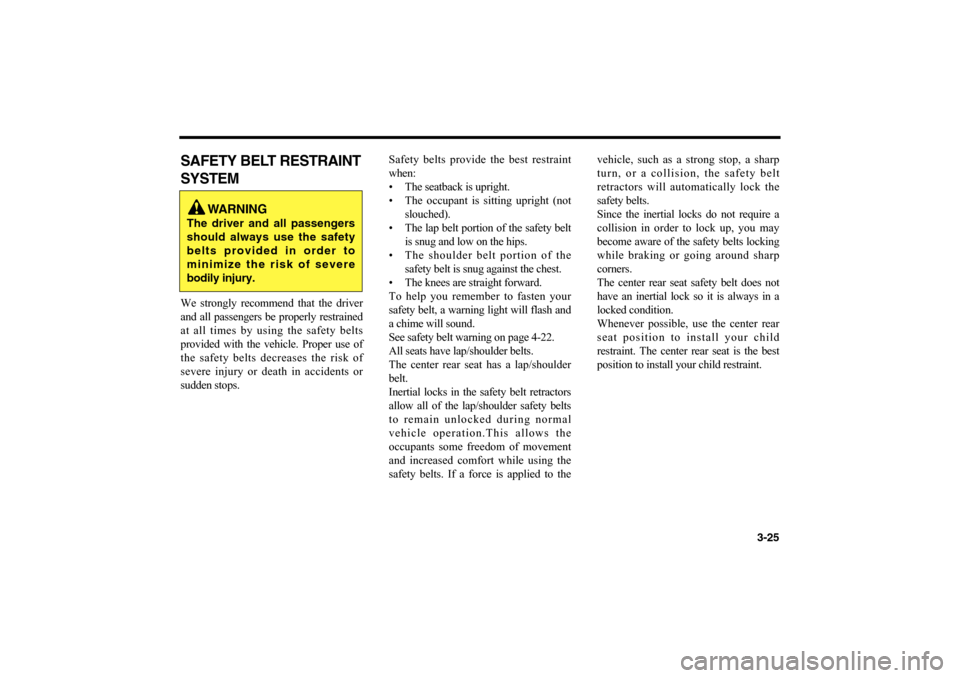
SAFETY BELT RESTRAINT
SYSTEMWe strongly recommend that the driver
and all passengers be properly restrained
at all times by using the safety belts
provided with the vehicle. Proper use of
the safety belts decreases the risk of
severe injury or death in accidents or
sudden stops.Safety belts provide the best restraint
when:
• The seatback is upright.
• The occupant is sitting upright (not
slouched).
• The lap belt portion of the safety belt
is snug and low on the hips.
• The shoulder belt portion of the
safety belt is snug against the chest.
• The knees are straight forward.
To help you remember to fasten your
safety belt, a warning light will flash and
a chime will sound.
See safety belt warning on page 4-22.
All seats have lap/shoulder belts.
The center rear seat has a lap/shoulder
belt.
Inertial locks in the safety belt retractors
allow all of the lap/shoulder safety belts
to remain unlocked during normal
vehicle operation.This allows the
occupants some freedom of movement
and increased comfort while using the
safety belts. If a force is applied to thevehicle, such as a strong stop, a sharp
turn, or a collision, the safety belt
retractors will automatically lock the
safety belts.
Since the inertial locks do not require a
collision in order to lock up, you may
become aware of the safety belts locking
while braking or going around sharp
corners.
The center rear seat safety belt does not
have an inertial lock so it is always in a
locked condition.
Whenever possible, use the center rear
seat position to install your child
restraint. The center rear seat is the best
position to install your child restraint.
3-25
WARNING
The driver and all passengers
should always use the safety
belts provided in order to
minimize the risk of severe
bodily injury.
MS-CNA-Eng 3.QXD 7/25/2005 5:17 PM Page 25
Page 37 of 225
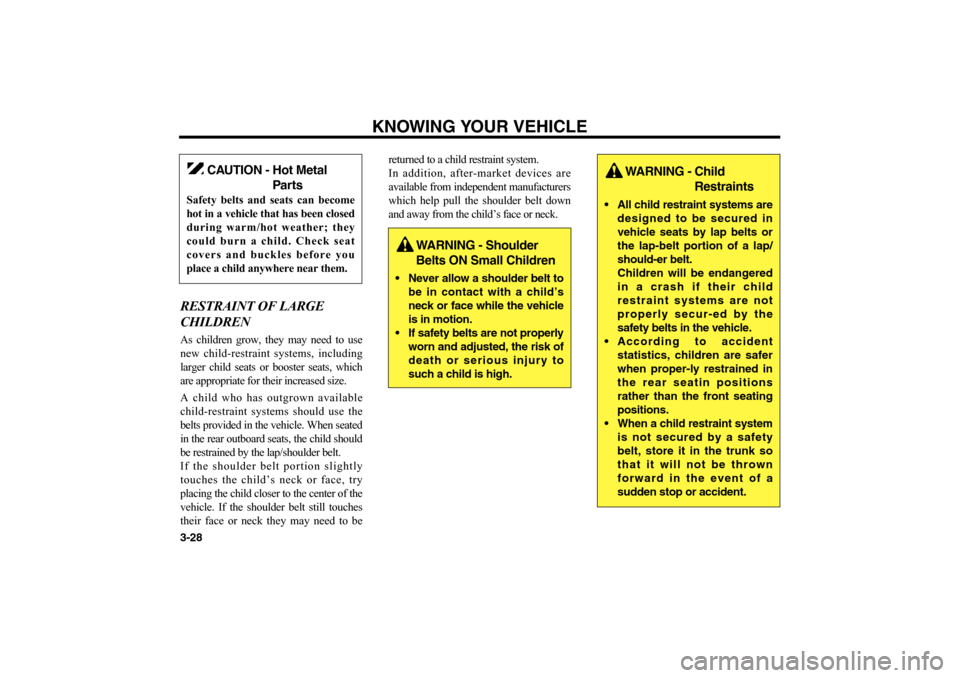
KNOWING YOUR VEHICLE
3-28RESTRAINT OF LARGE
CHILDRENAs children grow, they may need to use
new child-restraint systems, including
larger child seats or booster seats, which
are appropriate for their increased size.
A child who has outgrown available
child-restraint systems should use the
belts provided in the vehicle. When seated
in the rear outboard seats, the child should
be restrained by the lap/shoulder belt.
If the shoulder belt portion slightly
touches the child’s neck or face, try
placing the child closer to the center of the
vehicle. If the shoulder belt still touches
their face or neck they may need to bereturned to a child restraint system.
In addition, after-market devices are
available from independent manufacturers
which help pull the shoulder belt down
and away from the child’s face or neck.
CAUTION - Hot Metal
Parts
Safety belts and seats can become
hot in a vehicle that has been closed
during warm/hot weather; they
could burn a child. Check seat
covers and buckles before you
place a child anywhere near them.
WARNING - Shoulder
Belts ON Small Children
Never allow a shoulder belt to
be in contact with a child’s
neck or face while the vehicle
is in motion.
If safety belts are not properly
worn and adjusted, the risk of
death or serious injury to
such a child is high.
WARNING - Child
Restraints
All child restraint systems are
designed to be secured in
vehicle seats by lap belts or
the lap-belt portion of a lap/
should-er belt.
Children will be endangered
in a crash if their child
restraint systems are not
properly secur-ed by the
safety belts in the vehicle.
According to accident
statistics, children are safer
when proper-ly restrained in
the rear seatin positions
rather than the front seating
positions.
When a child restraint system
is not secured by a safety
belt, store it in the trunk so
that it will not be thrown
forward in the event of a
sudden stop or accident.
MS-CNA-Eng 3.QXD 7/25/2005 5:17 PM Page 28
Page 45 of 225
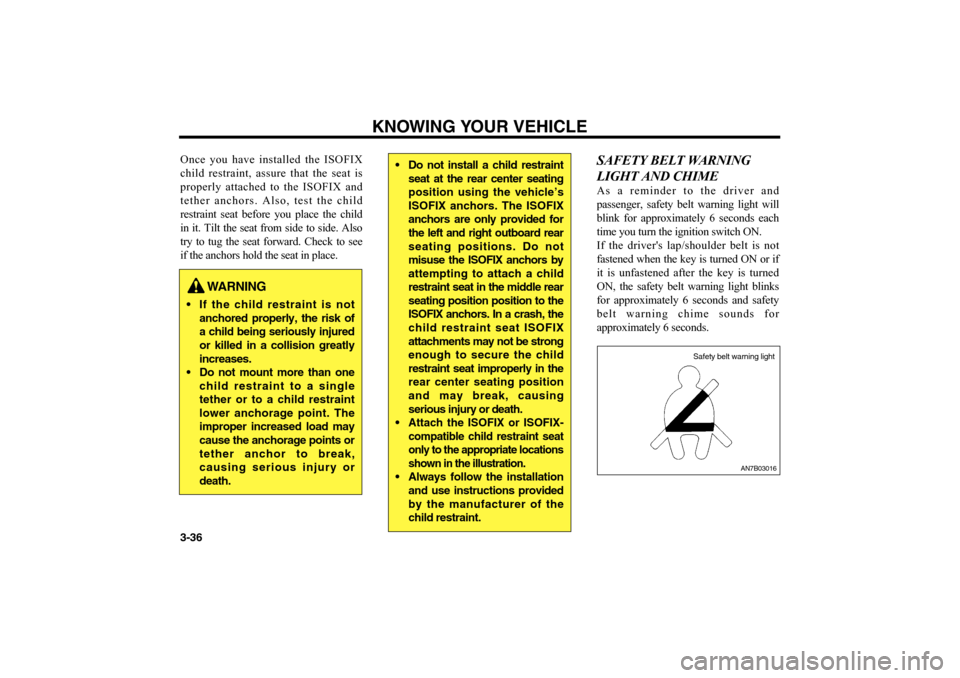
KNOWING YOUR VEHICLE
3-36 Once you have installed the ISOFIX
child restraint, assure that the seat is
properly attached to the ISOFIX and
tether anchors. Also, test the child
restraint seat before you place the child
in it. Tilt the seat from side to side. Also
try to tug the seat forward. Check to see
if the anchors hold the seat in place.
SAFETY BELT WARNING
LIGHT AND CHIMEAs a reminder to the driver and
passenger, safety belt warning light will
blink for approximately 6 seconds each
time you turn the ignition switch ON.
If the driver's lap/shoulder belt is not
fastened when the key is turned ON or if
it is unfastened after the key is turned
ON, the safety belt warning light blinks
for approximately 6 seconds and safety
belt warning chime sounds for
approximately 6 seconds.
AN7B03016
Safety belt warning light
WARNING
If the child restraint is not
anchored properly, the risk of
a child being seriously injured
or killed in a collision greatly
increases.
Do not mount more than one
child restraint to a single
tether or to a child restraint
lower anchorage point. The
improper increased load may
cause the anchorage points or
tether anchor to break,
causing serious injury or
death.
Do not install a child restraint
seat at the rear center seating
position using the vehicle’s
ISOFIX anchors. The ISOFIX
anchors are only provided for
the left and right outboard rear
seating positions. Do not
misuse the ISOFIX anchors by
attempting to attach a child
restraint seat in the middle rear
seating position position to the
ISOFIX anchors. In a crash, the
child restraint seat ISOFIX
attachments may not be strong
enough to secure the child
restraint seat improperly in the
rear center seating position
and may break, causing
serious injury or death.
Attach the ISOFIX or ISOFIX-
compatible child restraint seat
only to the appropriate locations
shown in the illustration.
Always follow the installation
and use instructions provided
by the manufacturer of the
child restraint.
MS-CNA-Eng 3.QXD 7/25/2005 5:17 PM Page 36